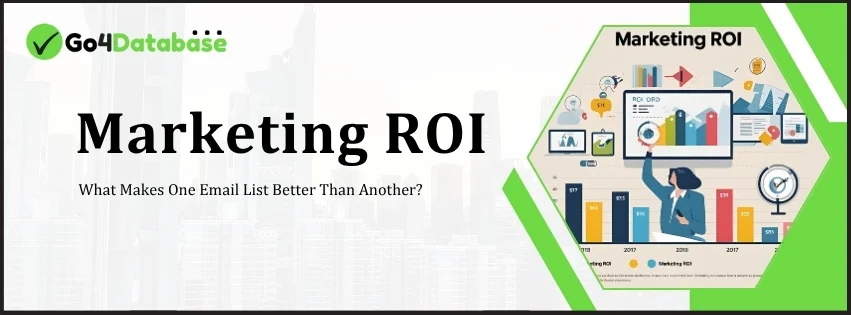Greetings, Dear Reader!
Glad you dropped by.
Yes! As you have already read, this blog is about a popular yet important topic, that is Marketing ROI (Marketing Return On Investment).
So, let's get ready!
Ladies and Gentlemen, I (Payal) will be your guide.
Table Of Content: Marketing ROI
1. Why Email Lists Matter for Marketing ROI
2. Understanding Marketing ROI in the Context of Email
3. Power of a Quality Email List
4. Key Factors That Differentiate One Email List from Another
5. How List Quality Impacts Your Email Marketing ROI
6. Tools to Evaluate and Improve Your Email List Quality
7. Conclusion: Let's wrap it up
Introduction: Why Email Lists Matter for Marketing ROI
What is marketing ROI?
It’s the return on investment (Marketing ROI) that marketing quantifies to justify how marketing programs and campaigns generate revenue for the business.
Marketing ROI is short for return on investment.
And in this case, it is measuring the money your company spends on marketing campaigns against the revenue those campaigns generate.
Marketing ROI Key Terms:
- Leads: New prospects generated by a marketing campaign.
- Incremental sales: New revenue generated by a marketing campaign (see "Incremental Sales").
- Wins: New customers generated by a marketing campaign.
A high Marketing ROI means your campaigns are making more money than you spend on them, and that's exactly what you want.
Nobody likes wasted budgets, especially when purse strings are getting tighter.
Calculating your marketing ROI enables you to see which activities have the most impact.
How do you calculate marketing ROI?
Simply put, Marketing ROI compares the profits that resulted from your campaign to how much the overall campaign cost.
A basic calculation for measuring marketing ROI is.
TL;DR
Marketing ROI measures how much profit a campaign generates versus its cost. It helps businesses allocate budgets wisely, track project success, plan efficiently, and stay competitive. Accurate revenue attribution is key. High ROI means strong returns, enabling smarter decisions and better resource use for long-term business growth.
Marketing ROI = (Net profit of your digital marketing campaign/Total cost of your digital marketing campaign) x 100
Of course, this calculation depends on accurate revenue attribution.
Revenue attribution involves matching revenue from customers to specific marketing activities, and it’s the secret to developing campaigns that will have real impact on your bottom line.
To do this, you need full visibility of the revenue data associated with all marketing activities.
Why is Marketing ROI important?
Both the marketing department and the company ought to know the Marketing ROI so they know whether their marketing activities are successful.
Companies ought to know how they're spending on marketing and how much profit the marketing produces so they can ensure they're allocating their resources efficiently.
Here are some aspects of business that understanding the Marketing ROI can help with:

Get High-Quality, Segmented Email Lists That Actually Convert
Stop wasting time on low-performing contacts. Access verified, targeted email databases to boost your ROI and conversion rates instantly.
Budget allocation
Marketers report to those at director level on how successful their activities are and how they help generate profits.
Without a clear Marketing ROI, it's difficult to justify budget requests for further marketing campaigns and innovations.
Company directors are also more inclined to reduce marketing budgets if they can't see a clear Marketing ROI for the business.
Financial health
While a company may sustain a short-term negative Marketing ROI to give time for a marketing campaign to work, companies ought to have good cash flow and ultimately make a profit.
Companies have staff and customers relying on them, so they can't afford too many months with a negative Marketing ROI.
To keep the business running in the long term and plan for success, the company and the marketing department ought to keep an eye on their Marketing ROI.
This allows them to see where profits are coming from.
Prioritising current projects
Keeping track of Marketing ROI allows marketers to monitor their current projects and decide whether they're working.
The marketing manager can then prioritise successful projects and give them more resources.
They can also stop unsuccessful projects to allow the team to focus on campaigns that work.
Planning and allocating resources
With clear figures for Marketing ROI, the marketing department can plan ahead with confidence.
They can also allocate staff and resources correctly and ensure employees use their time efficiently.
Clear metrics also ensure that marketers can reduce waste.
A record of Marketing ROI can outline the main marketing activities that work for the business.
This enables them to focus on successful activities and allocate more money and resources effectively.
Over time, this allows the marketing department to refine and improve its activities and Marketing ROI.
Keeping an eye on the competition
By accessing company records, marketers can easily get information on their competitors.
They can then look at income and Marketing ROI and analyse what their competitors are doing to market their business more effectively.
By using this information, they can learn from successful marketing methods and apply them in their own marketing.
Understanding Marketing ROI in the Context of Email
Let’s break it down. ROI stands for “Return on Investment.”
It simply means “Am I getting more out of this than I’m putting in?” Now, when we talk about Marketing ROI in emails, we’re asking:
“Is the money, time, and effort I’m spending on email campaigns actually bringing in results like sales, leads, or loyal customers?”
Imagine you run a small online store. You decide to send an email to 1,000 people about a new product.
That email costs you ₹500 in total design, tools, everything.
Now, say 20 people from that email end up buying your product and you make ₹5,000.
TL;DR
Marketing ROI in email campaigns measures if your efforts (money, time, tools) bring valuable results like sales or leads. A smaller, engaged email list yields better ROI than a large, uninterested one. Quality matters more than quantity in email marketing to achieve positive returns.
That’s a solid return! The Marketing ROI here is positive you're earning more than you spent.
Victory dance time!
But if only one person buys and you earn ₹250, you’ve just lost money.
That’s a poor Marketing ROI.
Why does this matter?
Because email might be cheap compared to ads or influencers, but if you’re sending it to people who don’t care or don’t open it, then it’s wasted effort.
That’s why the quality of your mailing list really matters.
A small list of interested people is way more powerful than a massive list of random ones.
Good Marketing ROI from email marketing doesn’t just happen.
It depends on who you’re emailing, how often, and whether your content is actually helpful or exciting for them.
So, in short: Email marketing ROI is a way to measure whether your email campaigns are worth it, and a better email list can make a huge difference in that success.
Power of a Quality Email List
In the world of marketing, there's a lot of noise, social media ads, influencers shouting into the void, pop-ups that make you want to throw away your phone.
But amongst all this chaos, one quiet performer consistently brings results: email.
And not just any email, emails sent to a quality email list. Now, you might be wondering, what exactly is a "quality email list"?
It's a list of people who have given you permission to contact them, and more importantly, they actually want to hear from you.
They're not just random contacts you've scraped off the internet.
They're people who said, “Yes, I want to stay in touch,” and that simple yes holds more power than it looks.
You see, a quality email list isn’t about size. It’s about connection.
A small list of 500 genuinely interested people will always outperform a giant list of 10,000 unengaged subscribers.
Why?
Because people who care are the ones who open your emails, read them, click through, and even buy what you’re offering.
The others? They scroll past, delete, or worse mark you as spam. Sending emails to the right audience means you're not shouting into the void.
You're having a conversation with people who are actually listening. That’s powerful. And that’s what makes a quality list worth.
When you send an email to a high-quality list, you’ll notice:
- Higher open rates, because people are curious to hear from you.
- Better click-through rates, because your offers match their interests.
- More conversions, because they trust you and find your products useful.
- Fewer unsubscribes and spam complaints, because they want you in their inbox.
And it’s not just about sales. A good list helps build your brand, too.
When subscribers consistently find value in your emails whether it’s tips, news, offers, or insights they begin to see you as a trusted voice.
You become more than just another brand. You become part of their world, their preference.
A quality list also makes your marketing smarter.
You can segment people based on what they like, how they behave, or what they’ve bought before.
That way, your messages feel more personal, more relevant, and less like generic mass emails.
And people love that. Nobody wants to feel like just another name in a database. But building a quality list doesn’t happen overnight.
It takes patience. It takes providing real value. It means being honest, consistent, and respectful.
No buying email lists, no sneaky tricks, no flooding inboxes. Quality lists are grown, not grabbed.
In a world where attention spans are short and competition is high, having a loyal, engaged group of email subscribers gives you a serious edge.
It's one of the few marketing tools you truly own. No algorithms, no pay-to-play rules.
Just you, your message, and a list of people who care. That’s the power of a quality email list.
Key Factors That Differentiate One Email List from Another
Not all email lists are created equal.
While on the surface, two businesses may both have 5,000 subscribers on their lists, the outcomes from their email campaigns could be wildly different.
One could be getting high open rates, great conversions, and consistent sales, while the other is barely getting clicks.
TL;DR
Not all email lists are equal. What sets a great list apart is quality, not quantity. Key factors include segmentation, subscriber engagement, clean opt-in sources, regular list hygiene, and audience relevance. A smaller, targeted, active list will always outperform a large, disengaged one. Focus on value, not just volume.
Why does that happen? Because what really matters is what’s going on inside that email list, not the number, but the quality.
Let’s dive into the five major factors that differentiate one email list from another.
1. List Segmentation
Imagine going to a shoe store and the salesperson starts pushing high heels on you when you clearly walked in wearing sneakers and a hoodie.
That’s what it's like when brands don’t segment their email lists.
List segmentation is the practice of dividing your email list into smaller groups based on shared traits like interests, past purchases, age, location, gender, or behavior.
It’s basically marketing with respect.
A segmented list allows you to send the right message to the right people at the right time.
When you segment well:
- You increase open and click-through rates.
- You reduce unsubscribes.
- You improve overall email engagement and conversions.
In short, segmentation helps your emails feel less like spam and more like a personal message and that changes everything.
2. Subscriber Engagement Levels
The size of your list doesn’t matter if no one’s engaging with your emails. Subscriber engagement refers to how your audience interacts with your emails.
Do they open them? Do they click?
Do they reply or share?
These are the signs of life that show your email list is healthy. A high engagement rate is a clear signal that your subscribers are:
- Interested in what you’re saying.
- Trusting your brand.
- Seeing value in your content or offers.
On the flip side, low engagement could mean your emails are boring, irrelevant, or too frequent.
Maybe you’re shouting into a crowd that just isn’t listening. Email service providers (like Gmail or Outlook) are smart.
If your emails keep going unopened or ignored, they may start sending your emails straight to spam even for people who want to hear from you.
That’s the digital version of being left out. So regularly check your engagement metrics:
open rates, click-through rates, bounce rates, unsubscribes, and spam complaints.
And don’t be afraid to clean out inactive subscribers.
It's better to have 1,000 people who care than 10,000 who don’t even notice you.
3. Source and Opt-In Method
Let’s talk about where your subscribers actually come from because how someone joins.
Your list says a lot about what kind of subscriber they'll be. There are two kinds of lists:
Permission-based and purchased. Guess which one works better? (Hint: it’s not the one you paid for.)
A quality email list is made of subscribers who have given clear, intentional consent to receive your emails.
This usually happens through opt-in forms, lead magnets, signup popups, or after a purchase.
These people have a reason to connect with you, and that matters.
Purchased or scraped lists, on the other hand, are filled with people who didn’t ask to hear from you.
Emails to these lists often get marked as spam, hurt your sender reputation, and could even get you blacklisted.
It's risky and often illegal under data protection laws like GDPR or CAN-SPAM.
Even within permission-based lists, the opt-in method makes a difference:
- Single opt-in: People subscribe once and start getting emails.
- Double opt-in: People subscribe, then confirm via email. This adds an extra step but ensures only genuinely interested people make it onto your list.
The better the source and the clearer the consent, the stronger and more responsive your list will be.
4. Email List Hygiene
Would you drink from a glass that hasn’t been washed in a year? Probably not. The same goes for your email list. It needs cleaning.
Email list hygiene is all about keeping your list up-to-date, accurate, and free from harmful addresses.
Over time, people change emails, stop engaging, or enter fake data.
If you keep sending to these addresses, your bounce rate goes up, your open rate drops, and your email reputation tanks.
Good list hygiene includes:
- Removing hard bounces (invalid emails).
- Removing or re-engaging inactive users.
- Eliminating duplicate or fake signups.
- Using email validation tools to filter low-quality signups.
A clean list means your emails are reaching real people, not ghosts or bots.
It improves deliverability, keeps you out of spam folders, and shows that you respect your subscribers’ space.
It’s like tending a garden you’ve got to pull the weeds if you want the flowers to grow.
5. Relevance to Target Audience
This one’s the heart of everything: Is your list full of people who actually want what you're offering?
If your business sells organic skincare, your ideal subscribers are people who care about clean beauty, not people interested in motorbike accessories.
Even if they both joined your list somehow, only one group is likely to convert.
You can build relevance in your list by:
- Being clear on your website or forum about what people will get.
- Creating lead magnets that only attract your ideal audience.
- Using content, offers, and tone that resonate with your niche.
Relevant subscribers are more likely to engage, stay subscribed longer, and turn into paying customers.
Irrelevant ones are just nonsense. Think of your list like a dinner party.
Would you rather have 20 guests who are excited, engaged, and laughing with you, or 100 guests who are on their phones, waiting to leave?
How List Quality Impacts Your Email Marketing ROI
Email marketing can be a powerful tool for businesses.
But the success of your email campaigns depends on the quality of your email list, not just its size.
A high-quality list can lead to better results and higher return on investment ( Marketing ROI).
The first way list quality affects Marketing ROI is through engagement.
People who are interested in your brand are more likely to open your emails. They are also more likely to click on links and buy products.
If your list is full of people who are not interested, your open and click rates will be low.
This leads to a poor Marketing ROI. Segmentation is another important factor.
By dividing your list into smaller groups, you can send more relevant emails.
For example, you can send special offers to people who have bought from you before, or remind people who left items in their cart.
This makes your emails more likely to get attention and lead to sales, which improves Marketing ROI.
Email list hygiene is also crucial. Over time, email lists can have invalid or inactive email addresses.
Sending emails to these addresses can increase bounce rates.
High bounce rates hurt your deliverability and can get your emails sent to spam.
Regularly cleaning your list ensures your emails go to real subscribers, which helps maintain a good sender reputation.
A clean list leads to higher engagement and better Marketing ROI. The source and opt-in method of your list matter too.
People who willingly sign up for your emails are more likely to engage with your content.
If you buy or scrape email lists, your emails might be sent to people who don’t want them.
This wastes resources and lowers Marketing ROI.
Using a double opt-in process, where people confirm their subscription, ensures better list quality and higher engagement.
Finally, relevance to your target audience matters. A quality list is made up of people who are interested in what you offer.
Sending relevant emails leads to higher conversion rates.
If your emails are not relevant, people will ignore them, and your Marketing ROI will suffer.
In conclusion, list quality plays a big role in email marketing ROI.
Engaged, relevant subscribers who have opted in to hear from you will help increase conversions and sales.
Regularly cleaning your list, segmenting your audience, and focusing on relevance will lead to better email marketing results.
By improving list quality, you can get more value from your email marketing efforts and see a better ROI.
Tools to Evaluate and Improve Your Email List Quality
Email list quality is crucial for effective email marketing.
A clean, engaged list leads to better open rates, higher click-through rates, and more conversions, ultimately improving your Marketing ROI.
Fortunately, there are several tools available to help you evaluate and improve the quality of your email list.
Here are some of the best tools to ensure your list remains high-quality and effective.
1. ZeroBounce
ZeroBounce is an award-winning email verification and deliverability platform helping 400,000+ customers improve their email ROI and inbox placement.
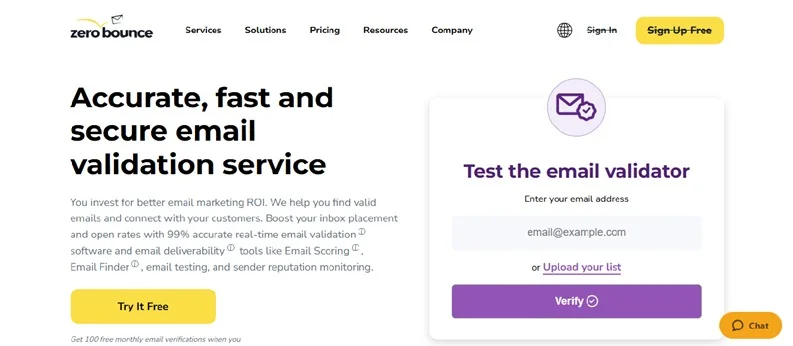
Its premier deliverability services include:
- 99% accurate email validation - Remove outdated and risky email addresses to lower email bounce rates and maintain a positive sender reputation.
- Email Finder - Find new, valid business email addresses and scale your B2B outreach
- DMARC Monitor - Secure your emails and prevent phishing scams with unlimited email monitoring, security alerts, and automated reporting
- Email Deliverability Tools - Improve inbox visibility with customized toolkits. Includes email server testing, inbox placement testing, Best Email Finder Tool, and DMARC Monitoring
- Activity Data & Email Scoring - Find your most active email subscribers with Activity Data.
Read Also: 8 Powerful Email Finder Tools: Tested, Reviewed & Compared
Additionally, Email Scoring service provides more in-depth insights about your email list to help you achieve email list success.
It also checks for spam traps and emails that are likely to bounce. You can ensure that only valid, engaged subscribers remain on your list.
Also it helps you maintain a good sender reputation and improves deliverability.
2. NeverBounce
NeverBounce is another tool designed to improve email list quality. It identifies invalid, disposable, and low-quality email addresses.
NeverBounce is the best because it’s quick, accurate, and easy to use.
We can customize email verification with tailored integration options.
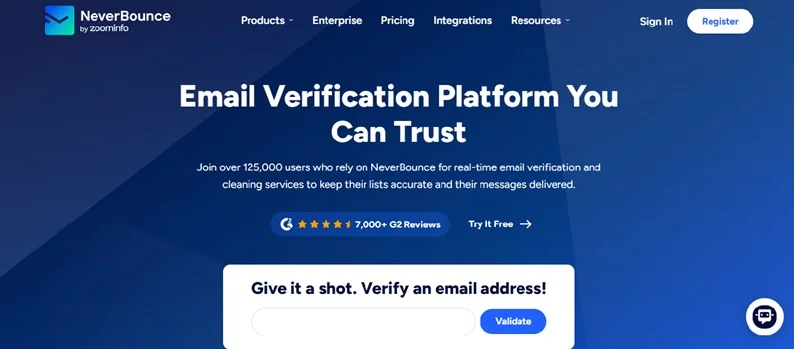
It integrates smoothly with popular platforms.
Keeps email lists clean, and is affordable for businesses of all sizes and its bulk verification makes managing large lists hassle-free, which really helps with deliverability.
It helps reduce bounce rates by cleaning your business email list before you send campaigns.
The tool integrates with several email marketing platforms.
Making it easy to run email verification alongside your regular campaigns.
3. BriteVerify
BriteVerify helps clean your email list by providing real-time email verification.
It’s particularly useful for preventing bad data from entering your email system in the first place.
BriteVerify is the contact validation solution that ensures a high-quality data foundation so you can generate more ROI from your sales lead generation, marketing, and service channels.
Representing over a decade of experience and expertise.
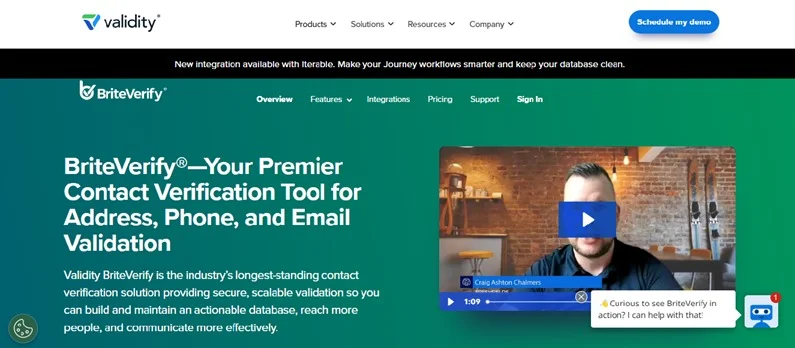
BriteVerify provides secure, scalable validation so you can list building tools and maintain an actionable database, reach more people, and communicate more effectively.
It can be integrated with popular email marketing tools.
Like Mailchimp, Salesforce, and others, making it easy to clean your list as part of your regular workflow.
This tool helps you focus on high-quality leads, ensuring better deliverability and engagement.
4. Mailchimp
Mailchimp is not only an email marketing platform but also includes features that help you maintain list quality.
Key features of Mailchimp include customizable email campaigns that utilize beautiful, pre-designed templates alongside an intuitive drag-and-drop editor.
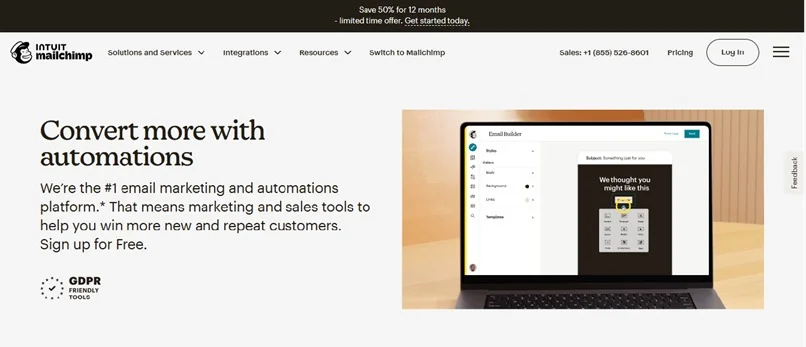
This functionality enables users to craft professional emails that resonate with their brand’s voice.
It offers tools for segmenting your audience based on different criteria. Such as engagement levels, demographics, and purchase history.
This ensures that you’re sending the right message to the right audience.
Mailchimp also provides analytics and reporting tools to track your email performance.
Helping you understand which subscribers are most engaged.
5. Klean13
Klean13 is a comprehensive email verification tool. It helps you clean up your email list by identifying invalid addresses.
It ensures you’re only sending emails to real users.
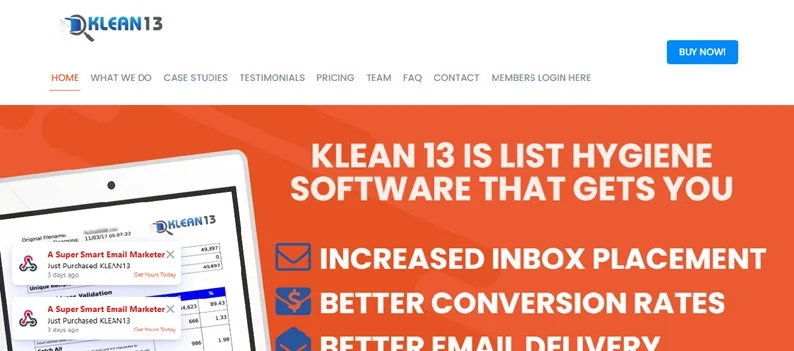
It also filters out email addresses that have been flagged as spam traps.
Klean13 helps you maintain list hygiene.
It prevents high bounce rates, and ensures your emails reach the right audience.
6. Hunter
Hunter is a tool for finding and verifying email addresses. It is widely used for building high-quality email lists from scratch.
Read Also: Hunter.io Alternatives? Try these 11 Websites Like Hunter!
It ensures that each email address is valid before sending.
You can also use it to verify email addresses from a list you already have.

Hunter offers both bulk email verification and single-email validation.
Making it a flexible tool for improving list quality.
7. Active Campaign
ActiveCampaign is a marketing automation platform.
It offers advanced list management features, including segmentation and list hygiene tools.

It helps you keep your list clean by automating the process of removing inactive subscribers and managing engagement.
ActiveCampaign’s reporting tools also provide insights into which segments of your list are performing best.
Allowing you to optimize your campaigns for better Marketing ROI.
8. Mailgun
Mailgun is an email automation and email verification tool. It focuses on improving deliverability and list quality.
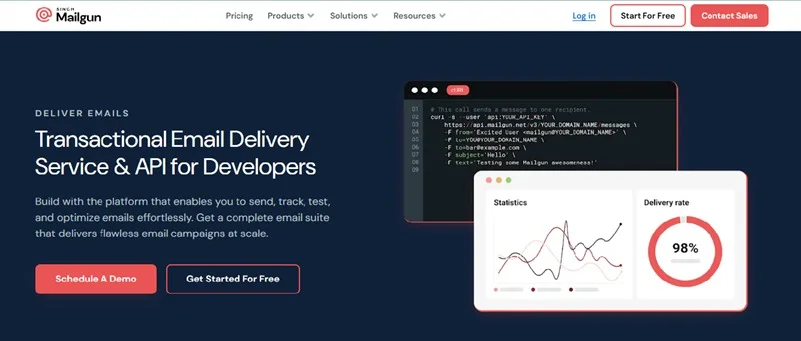
It provides real-time email validation, checking each email address for issues before sending messages.
Mailgun also offers detailed analytics.
It allows you to monitor the health of your email list and make necessary adjustments.
9. Optin Monster
OptinMonster is a tool for growing your email list by optimizing opt-in forms.
It helps you attract high-quality subscribers.
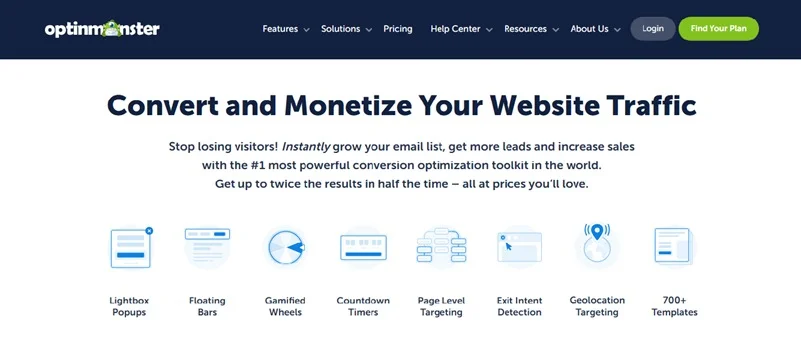
By using exit-intent pop-ups, floating bars, and other engaging techniques.
By customizing your opt-in forms to target your ideal audience.
You can ensure that the subscribers you add to your list are genuinely interested in hearing from you, improving list quality.
10. Clever Reach
CleverReach is another email marketing platform that offers features to improve list quality.
It helps you clean up your email list.

You can remove inactive subscribers and allow you to segment your audience based on engagement.
By focusing on high-quality subscribers.
You can increase your email campaign’s effectiveness and ultimately improve your Marketing ROI.
Conclusion: Let's wrap it up
Smart list building tools boosts email Marketing ROI. Focus on quality, not just numbers.
Use verified opt-ins and segment wisely. Clean your list often. Engage real, interested people. This saves money and improves results.
A strong, healthy list brings better opens, clicks, and conversions. Invest wisely and watch your email marketing grow.
FAQs:
1. What is Marketing ROI and why is it important?
Marketing ROI measures the return you get from your marketing efforts compared to the money you spent.
Also you've already read this blog, and it's all about the benefits of Marketing ROI.
It helps you see what’s working and where to invest more.
2. How can I increase my marketing ROI through email campaigns?
By targeting the right audience, using quality email lists, personalizing content, and tracking key metrics like open and conversion rates, you can boost your ROI.
3. Can purchased email lists hurt my Marketing ROI?
Yes, purchased lists usually include unengaged or fake contacts.
They often lead to spam complaints and low engagement, damaging your ROI and reputation.
